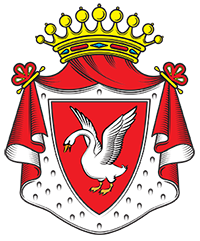History
The village of Głębowice is located in the western part of the Małopolskie (Lesser Poland) Voivodeship, along a local road connecting Oświęcim with Andrychów, 10 km from Zator and 15 km from Wadowice. The village is situated in a vast valley along the Stronik stream and borders, among others, Nidek, Osiek, Gierałtowice, Gierałtowiczki, and Polanka Wielka. Within the area of Głębowice, there are several complexes of fishponds that are part of the so-called Carp Valley, a characteristic system of ponds and embankments shaped during medieval times and still exploited to this day.
The earliest mentions of Głębowice date back to the second half of the 13th century when a village named ecclesiae de Glambowicz appeared on the map of the Duchy of Oświęcim. In the first half of the 15th century, Głębowice came into the possession of a knightly family bearing the Kornicz coat of arms, whose members adopted the surname Głębowski. At the beginning of the 16th century, the village passed into the ownership of the Gierałtowski family of the Szaszor coat of arms.

Castle in the Duchy of Zator, 14th century.
GIERAŁTOWSKI FAMILY
It is probable that there was once a defensive castle in Głębowice, serving as the stronghold of Beskid bandits, and it was on its site that Jakub Gierałtowski, a judge of the Duchies of Oświęcim and Zator, erected a new tower manor surrounded by a moat. During Jakub's time, Głębowice became a thriving center of Calvinism, and the manor served as an important seat of the Polish Reformation.
After Jakub Gierałtowski's death in 1564, his tombstone was preserved, which in the mid-19th century Tytus Dunin ordered to be built into a pillar of the local church fence, where it remains to this day and constitutes the oldest tombstone of this type in the Małopolska (Lesser Poland) region.
PISARZOWSKI FAMILY
In 1636, the Gierałtowski family sold Głębowice to the starost of Oświęcim and Barwałd, Krzysztof Komorowski, who then, probably due to the passage of time, passed the estate - deserted, neglected, and in poor condition - to his relative, the next judge of the Duchies of Oświęcim and Zator, Jan Pisarzowski of the Starykoń coat of arms.
In 1646, Pisarzowski initiated the expansion of the Głębowice residence and partial replacement of the interior furnishings, transforming the modest manor into a magnificent Renaissance-style residence resembling a palace. This event was commemorated by a foundation plaque, the lower part of which consisted of a baroque cartouche with a convex, elliptical shield surrounded by a pearl string with a Latin inscription. The upper part of the plaque featured a richly carved heraldic shield divided into four sections with the coat of arms of Starykoń, Korczak, Kornicz, and Nabram III(?), adorned with lavish labra and a helmet with a crown topped with a battle-axe, belonging to the Starykoń coat of arms.
The plaque, embedded above the entrance to the palace from the northern side, remained there until 1999 when it fell victim to theft.

Foundation plaque from 1646 with a Latin inscription: Jan of Pisarzowice, Pisarzowski courtier. Zator, Oświęcim and other lands, destroyed, he renewed and redecorated again in the year 1646. (free translation)

The northern gate of the palace with the foundation plaque and heraldic shield.
In 1647, Pisarzowski commissioned the construction of an oval, baroque tiled stove in one of the rooms. In the upper part of the stove, large tiles with coats of arms containing the Starykoń coat of arms, the letters J.P.Z.P.Z.O.Z.P. (meaning: Jan Pisarzowski from Pisarzów in the Oświęcim and Zator Lands, Scribe), and the year 1647, were rhythmically arranged.

Baroque tiled stove from 1647, next to the fireplace. Głębowice 1939.
In the second half of the 18th century, at the initiative of another owner of Głębowice, the Kraków standard-bearer Adam Pisarzowski, the palace was rebuilt in the Baroque style. Additionally, it was surrounded by an Italian geometric garden to the north and a landscape park to the east. This event was commemorated by the embedding of a foundation plaque made of red marble with a Latin inscription in the year 1773.

Adam of Pisarzowice, Pisarzowski Vexillifer (standard-bearer) in the Kraków Palatinate, renewed and embellished this temple, which previously around the year 1646, by Jan the Judge of the Duchies of Zator and Oświęcim, as the inheritance of his ancestors, was rebuilt and renovated. Eventually, in difficult times or due to neglect by subsequent owners, it became greatly damaged, Adam restored, revived, and decorated it for the benefit of his family and the comfort of guests. After changing the style of the entrance, he planted a visually pleasing garden with selected fruit trees. The year of Our Lord 1773.
(free translation)
DUNIN FAMILY
The foundation plaque survived until 1826 when the estate in Głębowice was acquired from Adam's son, Jan Pisarzowski, by Ludwik Dunin of Skrzynno (1790 - 1833), the owner of Gierałtowice.
A strange event accompanied the sale of Głębowice. When Jan Pisarzowski left the castle, bidding farewell to the tearful people, the red plaque with the inscription of the foundation, as if to signal that it was no longer needed there, detached from the wall, fell at his feet, and shattered into pieces. This made such an impression on the chamberlain that he ordered it to be framed in oak and used as a table until his death.
The Głębowice estate was owned by the Dunin family from 1826 to 1939 (1945). After Ludwik, who was remembered by the locals as a magnificent, noble, and generous host, the subsequent owners were: Tytus Dunin of Skrzynno, Albina Countess Bobrowska of the Boleścic coat of arms Duninowa Tytusowa, Stanisław Dunin of Skrzynno, Maria from the Ursyn-Pruszyński family of the Rawicz coat of arms Duninowa Stanisławowa, and Józef Stanisław Dunin of Skrzynno. The oldest inhabitants of the village remember this family with sympathy and great respect.
Ludwik's son, Tytus Dunin of Skrzynno (1819-1860), after marrying Albina Countess Bobrowska in 1844, began the renovation and partial reconstruction of the palace interiors and furnishing of the first floor. During the renovation works lasting over two years, a hidden compartment was discovered in the tower, containing an urn with ashes bricked into it. It was never possible to establish whose ashes they were, but they were buried with due respect.
After Tytus's death, the estate was inherited by his wife, Countess Albina Bobrowska Dunin (1822-1893), and then by their son, Stanisław Dunin of Skrzynno (1848-1903), a highly respected heir who was a true father and brother to his people. In 1888, Stanisław married Maria Ursyn-Pruszyńska of the Rawicz coat of arms, who after her husband's death leased Głębowice and moved with her children to the nearby manor in Kopytówka.
In accordance with Stanisław's will, Głębowice was inherited by his son Józef Stanisław Dunin of Skrzynno (1896-1980), who took over the management of the estate in 1920 when the lease agreement expired and was its last owner until 1939 (1945).
The property, which had been in the hands of negligent tenants for many years, was in a rather neglected state. Józef Stanisław conducted the renovation of the palace interiors, a thorough restoration and modernization of the entire facility, and recreated the 18th-century Italian geometric garden. In the interwar period, the Głębowice palace was considered one of the most splendid rural residences in Galicia, and in 1937, it was recognized as a monument of the first group.

The palace from the southeast with the castle pond, 1939.

The palace from the north with the geometric garden, 1928.
Thanks to Józef Stanisław’s considerable skills and, as he himself claimed, a rather fortunate hand, he relatively quickly brought the estate to a flourishing state.
During his time, it was a thriving and expanding farm with extensive orchards, vegetable gardens, a strawberry plantation (yielding up to two tons per day), and an asparagus bed (supplying up to 50 kg of asparagus per day during the spring season).

The orchard was established between 1922 and 1926 on a 7-hectare plot.
A model Swiss-style barn with sealed tanks for liquid manure was constructed, along with a modern farrowing unit for large English breed sows. Artificial pastures for cattle were created, and taking advantage of favorable terrain conditions on marshy meadows, numerous ponds for breeding royal carp were established. Additionally, a sauerkraut production facility and brickyard were launched.
Józef Stanisław, an avid hunter, organized game preserves to increase game populations on both his own and leased lands. He also specifically developed pheasant breeding.
Furthermore, he renovated farm buildings, constructed new quarters for agricultural workers, and participated, among other things, by providing land for free, in the establishment of a local dairy. He also initiated the construction of a new school, but it did not meet with the approval of the local community, and its establishment had to wait for another quarter of a century.

Farm buildings. Photo from 1970.
Many villagers found employment on the estate, and while working for the landlord, they were convinced of the benefits of using mowers, reapers, potato harvesters, and other agricultural machinery, gradually moving away from scythes, sickles, and hand potato planters.

The palace from the southern side with a fragment of the farmstead and the castle pond, 1937.
During the interwar period, the palace in Głębowice was a lively hub of social activity. It hosted receptions, meetings, balls, but most notably, renowned hunting events that were famous throughout the region. It was there that the Podkarpackie Koło Jazdy Myśliwskiej (Podkarpackie Hunting Club) was founded by Józef Stanisław, with the aim of promoting horse breeding and equestrian sports. A frequent guest at the estate was Henryk Dobrzański, known as Hubal.
WORLD WAR II
At the outset of World War II, the German authorities, recognizing the high level of the estate in Głębowice, established an agricultural school and a summer residence for the Hitler Youth organization on the property. The position of estate manager was assumed by von Weinetgrun Betriebsführer, who in January and February 1940 directed two letters to Ludwik Dunin, brother of Józef Stanisław, stating that all movable and immovable property of the castle was seized on behalf of the Reich Commissioner and nothing was allowed to be taken away.
The Germans immediately began adapting the palace for its new purposes, dismantling a number of original walls and rebuilding them elsewhere. They completely destroyed the library along with the family archive of the last owners of Głębowice, Latin and German books were taken away, while Polish ones were burned in the fireplaces for many years of occupation. A similar fate befell documents, portraits, miniatures, Saxon and old-fashioned porcelain, valuable works of art, and antiques, such as a reliquary and an ivory cabinet with the Passion of Christ. They mindlessly transformed antique furniture; for example, they turned a historic 17th-century wardrobe into bedside tables. They erected Finnish cottages in the park and arranged the Italian geometric garden with birch trees.
However, apart from that, German order and farming prevailed on the estate, and the gardens, orchard, and ponds were fully utilized, although fish production decreased by 80%.

The 17th-century wardrobe, which a carpenter from the renowned Cracow furniture company Iglicki estimated to be worth five years of work, was cut into nightstands. The top and bottom parts of the wardrobe opened upon pressing a secret button, causing the drawers to slide out thanks to installed springs.
Upon leaving the palace at the end of the war, the occupiers took away, among other things, two beautiful Renaissance portals, antique furniture, paintings, and they also dismantled the most magnificent artifact - the oval, baroque stove erected here in 1647 by Jan Pisarzowski. The subsequent history of the stove is not entirely clear, but it is known that in 1949, the then-director of the Jagiellonian University Museum, Prof. Karol Estreicher, transported it to the Collegium Maius and placed it in the representative Stuba Communis hall, where it remains to this day.

The tiled stove from 1647 with the Starykoń coat of arms in the Stuba Communis of the Jagiellonian University.

The tiled stove from 1647 with the Starykoń coat of arms in the Stuba Communis of the Jagiellonian University.
POST-WAR PERIOD
After the war, the estate was divided into parcels, and the palace was entrusted to the Breeding Center in Osiek. The palace rooms were converted into apartments for farm workers, offices, a staff canteen, grain, vegetable, and fruit warehouses, as well as a hatchery and poultry farm.
The timbered ceilings were whitewashed with lime, and the rooms were partitioned with walls, creating mirrored ceilings in some areas and a red salon with a beautiful, multi-level stucco ceiling. Surviving stucco fireplaces and oak and stone portals were vandalized or stolen. Even the bricks from which the palace walls were built were chiseled away, and the Renaissance polychrome ceiling beams were discarded. Several beautiful ornamental trees in the park were cut down, as well as the entire avenue of hornbeams. Stone benches and tables were smashed. Decorations and elements of the fence, two stone lions from the northern entrance gate, gateposts, and gate locks were taken to nearby Osiek. The seven-hectare orchard established in the 1920s was destroyed by grazing cows.

Remnants of the entrance gate, 1966.

Black and austrian pines were mutilated in a terrible way so that their shade would not fall on the granaries erected in the park next to the palace.
As reported in the press: the ground-floor rooms with barrel-vaulted ceilings adorned with lunettes and Renaissance stone window frames and portals were repurposed into a chicken hatchery, a staff canteen, and a kitchen (...). The palace and its surrounding park began to be overrun with weeds, pigsties, cellars, fuel depots and dog kennels.
Soon, the building was in a deplorable state - without necessary repairs, with a leaking roof covered in tin, water flowing down the walls from damaged gutters, spreading moisture throughout the walls, rotting wood and collapsing turrets.

When covering the roof with tin, the towers were not covered, causing both of them to be flooded with water.
Unfortunately, according to a letter from Józef Stanisław Dunin to the Provincial Conservator in 1968, the extent of the damage is staggering and the devastation far exceeded the wartime period...
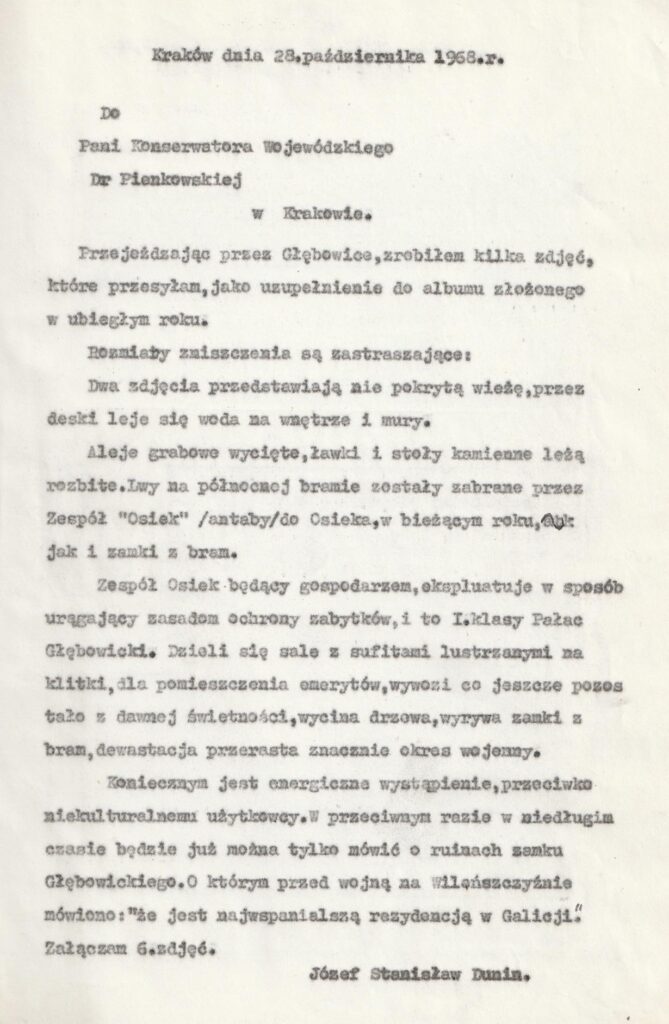
Kraków, October 28, 1968.
To Ms. Provincial Conservator Dr. Pienkowska in Krakow.
While passing through Głębowice, I took several photos, which I am sending as a supplement to the album submitted last year.
The extent of the damage is terrifying:
Two photos show an unprotected tower, with water leaking through boards into the interior and onto the walls.
The lime tree alleys have been cut down, stone benches and tables lie broken. The lions (antabs) from the northern gate, as well as the locks from the gates, were taken by the Center for Breeding Excellence in Osiek. to Osiek.
The Center for Breeding Excellence in Osiek, which is the host, is exploiting in a manner that violates the principles of monument protection (particularly the first-class monument) Głębowice palace. It divides rooms with mirrored ceilings into cages, for accommodating retirees, removes what little remains of its former splendor, cuts down trees, tears out gate locks; the devastation far exceeds wartime devastation.
It is necessary to take vigorous action against the uncultured user. Otherwise, soon we will only be able to speak of the ruins of the Głębowice castle, which before the war in the Wilno region was said to be "the most magnificent residence in Galicia."
I attach 6 photos.
Józef Stanisław Dunin
THE FIRE OF 1969
On the night of October 18th to 19th, 1969, just before two in the morning, boys returning from a village party noticed a column of fire above the palace. The building was ablaze like a torch. The fire broke out in the eastern part, quickly spreading across the roof and attic, engulfing the towers, rooms on the first floor, and the staircase.
The Volunteer and Professional Fire Brigades from nearby towns were powerless due to a lack of access to water. Three years earlier a flood had breached the embankments of the ponds, causing them to dry up and despite orders from the County Fire Department in Wadowice, the damage was not repaired. Water to extinguish the fire had to be transported by tanker trucks from a distance of 4 km. By morning only sad ruins remained of the palace. The first floor was completely destroyed with only parts of the ground floor partially surviving.

Southwest side with the entrance stone bridge to the courtyard. October 23, 1969 - four days after the fire.

Fragment of the northern facade with the Pisarzowski family foundation plaque from 1646 and the Łabędź coat of arms at the top. Photo taken four days after the fire.

Fragment of the southern facade with the gate and the Łabędź coat of arms. Photo taken four days after the fire.

Stone portal from the 16th century. Photo taken four days after the fire.

After the fire, in some burned rooms, previously unknown Renaissance polychromes were revealed under the plaster.

The hall and staircase are filled with charred beams, debris, and metal sheets.
Letter from Adam Jarzyna, a long-time estate worker, to Józef Stanisław Dunin containing words of sympathy and considerations regarding the causes of the fire:

Adam Jarzyna, a long-time employee (gardener) of the estate in Głębowice
October 25, 1969, Głębowice
With great heartache, I offer to the Honorable Benefactor my expressions of sorrow and sympathy for the catastrophe that occurred in the night from last Saturday to Sunday, due to the negligence of certain factors.
In my opinion, those who were covering the roof of this historic castle, by falsely reasoning that the ceiling would collapse under its weight, caused the upper floor to have no protection against fire. I think that if there had been a covering, made of bricks as it was, the upper floor would not have caught fire so quickly.
In my view, the second culprits bear moral responsibility - the Fish Farm Management Board. Two or three years ago, when the flood broke the embankment due to the small water passage, there were only single pipes and narrow ones at that, with little drainage. Here also, the blame lies with the current embankment supervisor, Jan Górkiewicz, known as Kubiak, for not taking care of those who installed the pipes, as it was not the first time the embankment had broken during a major flood. They should have built a concrete bridge there, like the one at Polański's pond in Farawiec, behind the forest.
Also, the P.G.R. management is to blame for not giving due attention to the Fish Farm Management Board, as there has been no water for 3 years near so many state-owned facilities. Under various circumstances, a fire can occur, and if there is no water nearby, it is impossible to save - straw and feed.
I sympathize greatly with the Honorable Benefactor; it must have been very dear and precious to him. Because he was born and raised under his roof, and also the Most Honorable Brothers and Sisters, Fathers and Grandfathers, etc.
And it was dear to me too, because I was raised there under Your caring supervision for 10 years, and I gained some social refinement and learned about public life and also as an object of historical and cultural heritage, as the late Mr. Kostyra told me about the events that took place there.
When I went to see the ruins, tears involuntarily welled up in my eyes.
In concluding this clumsy scrawl of mine, I offer deep bows and greetings to the Most Honorable and Esteemed couple. May the Lord Jesus grant you a long life with robust health and success in life, and comfort you after this loss.
Your little ward, A.J.
After the fire, the Provincial Conservator of Monuments covered the remnants of the palace with a flat, makeshift roof, which, being untreated, quickly collapsed. Since then, due to the lack of proper protection, the remnants of the monument have been subjected to a sad, uninterrupted decay.
21st CENTURY
In the remnants of the courtyard in the center of the village of Głębowice, amidst thickets of bushes and shrubs, one can discern the remnants of brick walls with sad eye sockets framing the window openings. Once, there was still a foundation plaque of the Pisarzowski family from 1646 above the northern entrance, and above the southern one - the Dunin family crest of the Swan. Once, you could still climb to the top of the western tower. I remember. I used to go up there.
Abandoned, neglected, unprotected, year after year, the ruins of Głębowice continued to undergo further silent processes of destruction and decay. More fragments of walls collapsed, cellar ceilings caved in. With knowledge and imagination, one can still occasionally discern traces of once beautiful avenues of hornbeams and remnants of earthworks and moats, but only memories remain of the former glory of this place.
Due to its location on the communication route from east to west, Głębowice were exposed to attacks and often had to endure the passage of various armies. The palace survived the invasion of the Hussites, Swedes, Austrian occupation, and two world wars, only to succumb to almost complete destruction in times of peace...
2018:
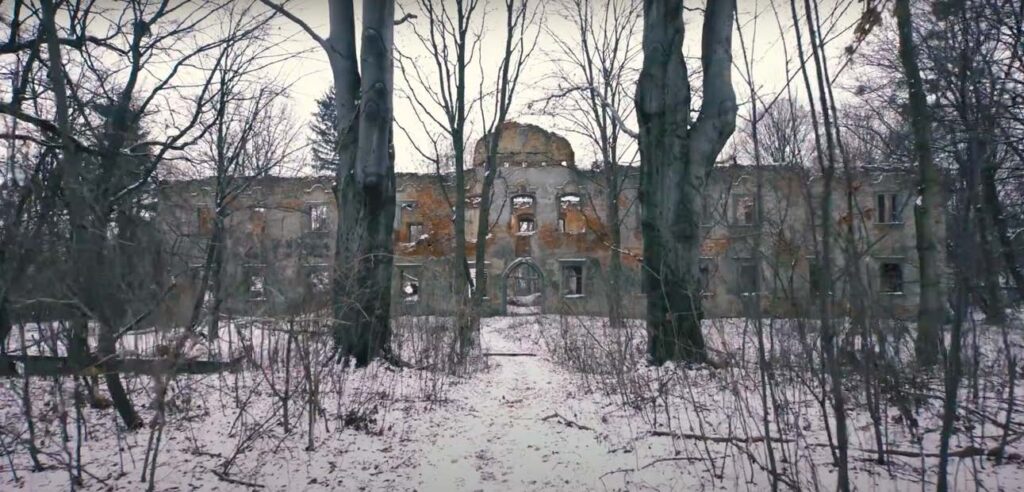

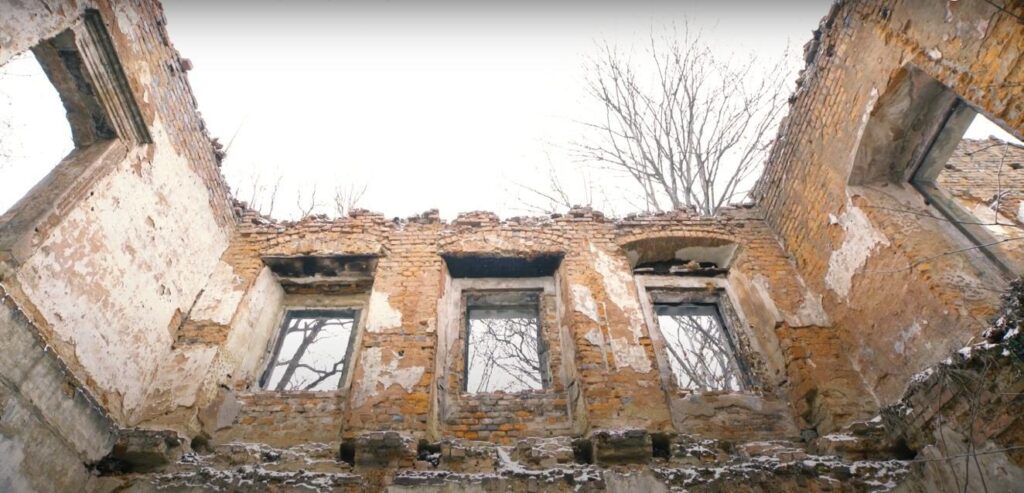
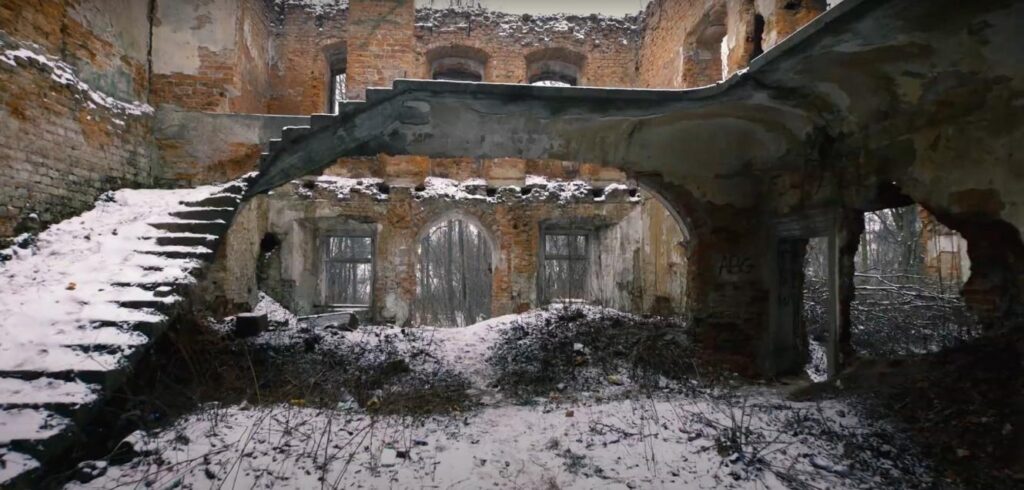
GŁĘBOWICE RETURN TO THE DUNIN FAMILY
In 1980 Józef Stanisław Dunin passed away in Krakow - the last owner of the Głębowice estate, for whom the palace was a home he never managed to return to.

After the death of Józef Stanisław, ownership of Głębowice passed to his only son, Piotr Józef Włast Dunin of Skrzynno (1946-2020). In 2019, after many years of effort and thanks to the invaluable dedication of Piotr's wife, Danuta of Nielubowicz, the Głębowice palace and park complex returned to the hands of the Dunin family.
Following Piotr Dunin's death in 2020, the owners of Głębowice became his wife Danuta, son Piotr Włast and daughter Barbara Anna.
